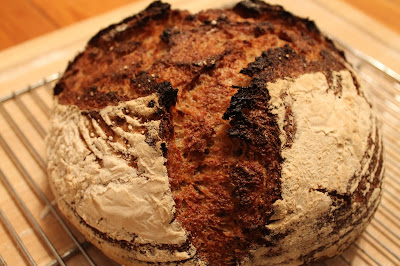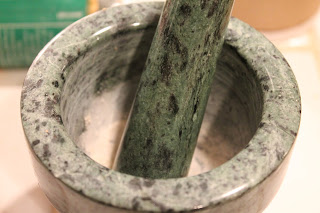 |
| 100% Spelt Bread; All pictures by Servia |
My plan this weekend was to make some 100% Whole Wheat bread to continue the 100% Whole Wheat project. However, I got sidetracked.
 |
| Wondermill Junior Delux |
As I mentioned, Egnatius gave me a grain mill for Christmas. I also mentioned that the tork on the grinder was threatening to break the table. Well, Servia went down to our garage and out that we hard a workbench-type-table that we hadn't seen in a few years (because it was upside down). So, we hauled it upstairs and, lo-and-behold, the grain mill works!
 |
| When I came back from mixing the dough, Gorgo was by the grain mill |
Little Gorgo was so entranced she wanted to pose by it.
Anyway, I bought some whole spelt kernels at whole foods the other day. They were much cheaper than buying the flour, interestingly enough. So I decided to try out the grinder on the workbench last night. And it worked really well! The flour was a little coarser than one might get in a bag (I have had to use the metal grinders instead of the stone ones because there is still grit in anything ground by the stones). However, it was still awesome.
 |
| Hand-ground spelt |
My father and his friend who was over for dinner said it was the best bread they've ever tasted. I thought it was delicious, but it was a little sweet for me.
First, I'd like to share my research. I decided to make the bread because of
txfarmer's amazing bread. I decided that I wanted to make this, but the loaf looked like it was going to be quite small so I doubled it. I didn't want to double the sweetener, though, so I just used 40g of agave. I also stole a few tricks from the
breadtopia recipe that she referenced.
Ingredients:
210g Spelt starter (100% hydration)
596g Spelt Flour
400g water
40g agave necter (you can replace this with honey).
14g salt
Directions:
- If you don't have a spelt starter, take a spoonful of your usual starter and feed it with X water and X spelt. Let it ripen until it passes the float test. If you have a spelt starter, skip this step
- Combine starter, flour, water, salt, and agave in a mixing bowl and mix until completely combined. I mixed a vitamin C tablet in with mine, but I actually don't think this helped the gluten like I thought it would. It didn't seem to negatively impact the flavor.
 |
| My new mortar and pestle that I used to crush the vitamin C tablet |
- Let the bread autolyse for 20-60 minutes. I let it for 60 minutes because the kitchen was fairly cold.
- I did a few stretch-and-folds and then let the bread rise for 2h at 80 degrees F, with a stretch-and-fold every half hour.
- Then I put the bread, covered tightly with plastic wrap, in the refridgerator overnight.
The next morning:
- I took the bread out and did a preshape.
- I let the bread bench rest for 45 minutes.
- Then I did a final shaping and put it in the banneton.
- I let it do a final proof for 2.5h at 80 degrees.
- Then I baked it at 440 degrees F convection, under steam for the first 35 minutes and then for another 15 minutes. Unfortunately, this was far too hot, so I had to cover the bread with tin foil and then let it finish until it read at 212 degrees.
Servius and his friend said it was the best bread they've ever had. More information soon.


